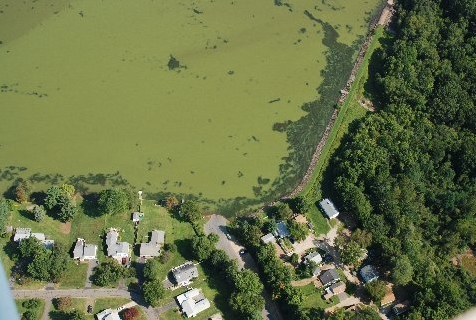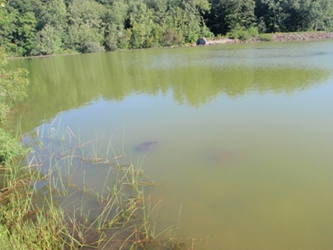Cyanobacteria Blooms
Also known as "blue-green algae blooms" or "harmful algae blooms (HABs)"
Cyanobacteria, also known as blue-green algae, occur naturally in lakes and ponds throughout Connecticut. These microscopic organisms often go unnoticed and cause no harm. However, excessive nutrient pollution and climate change are causing water bodies to experience more frequent nuisance cyanobacteria blooms that may produce and release toxins. When cyanobacteria blooms release toxins, people and animals using the water body for recreation can have health effects. It is important to note that not all algal blooms are harmful algae blooms (HABs), however it is not possible to determine the level of toxins in the water without a more detailed evaluation. Out of precaution it is best to avoid direct contact with water experiencing a bloom. When in doubt, stay out!
What Does a Cyanobacteria Bloom Look Like?

- The water may be cloudy or even thick like pea soup.
- It may look like someone spilled paint on the water.
- The water will likely be green or brown.
- There may be a mat of algae, scum or foaming on the water surface.
What is DEEP Doing About Cyanobacteria Blooms?
DEEP monitors the 21 State Beaches weekly for cyanobacteria blooms from Memorial Day weekend through Labor Day weekend. If a bloom is confirmed DEEP will close the State beach for swimming in consultation with the Department of Public Health. Please see the State Swimming Area Water Quality Report for the latest information on State beach closures.
In addition, the DEEP Monitoring and Assessment Program participates in regional and national work groups to keep up to date with the latest science on this emerging water quality threat. This includes participation in the U.S. EPA Cyanobacteria Monitoring Collaborative along with several ongoing studies to better track and understand the occurrence of cyanobacteria blooms and the relationship between blooms, toxin levels and pollutants.
How Can the Public Identify and Report a Suspected Bloom?
Learn How to Identify a Bloom:
Report Suspected Blooms:
If you believe that you have observed a cyanobacteria bloom, follow the guidance listed above and contact your Local Public Health Department.
If you are concerned that you may have been exposed to cyanobacteria and are having symptoms, contact your doctor or the Connecticut Poison Control Center at (800) 222-1222.
If you are concerned that your pet may have drank water with cyanobacteria and are having symptoms, contact your veterinarian. Additional information on animal safety can be found on the CDC website or on the following Animal Safety Alert.
For other health-related questions, contact the Environmental Health Section’s Public Beach Program at the CT Department of Public Health (DPH) at (860) 936-1125.
To help DEEP track the occurrence of blooms, please send the location, extent of the bloom, date observed and images via the U.S. EPA bloomWatch app or by email to deep.algalblooms@ct.gov as soon as the bloom occurs.
How To Learn More About Cyanobacteria Blooms

Above: Photograph of past cyanobacteria bloom in Connecticut
Occurrences of Cyanobacteria Blooms in Connecticut:
-
CT bloomWatch Reports – Citizen science observations reported through the U.S. EPA bloomWatch application. **Note that not all bloom reports have been verified.
-
Recent and Historical Cyanobacteria blooms in CT Report – Last Update 06/01/2020
Health Effects and Public Health Guidance:
Best Practices for Preventing and Managing Cyanobacteria Blooms:
Who to Contact for Additional Questions
For Health Questions: If you are concerned that you may have been exposed to cyanobacteria and are having symptoms, contact your doctor or the Connecticut Poison Control Center at (800) 222-1222. If you are concerned that your pet may have drunk water with cyanobacteria and are having symptoms, contact your veterinarian. For other health-related questions, contact the Environmental Health Section’s Public Beach Program at the CT Department of Public Health (DPH) at (860) 936-1125.
For Information About Town Beach Closings and Advisories: Call your Local Health Department.
For Information About State Beach Closings: Call the DEEP State Parks Swimming Area Water Quality Status Information Line at 866-CT-PARKS or (866) 287-2757 or Visit the State Swimming Area Water Quality Report Web Page.
For General Information on the Occurrence of Blooms in CT: Email deep.algalblooms@ct.gov
Content last revised June 3, 2025

